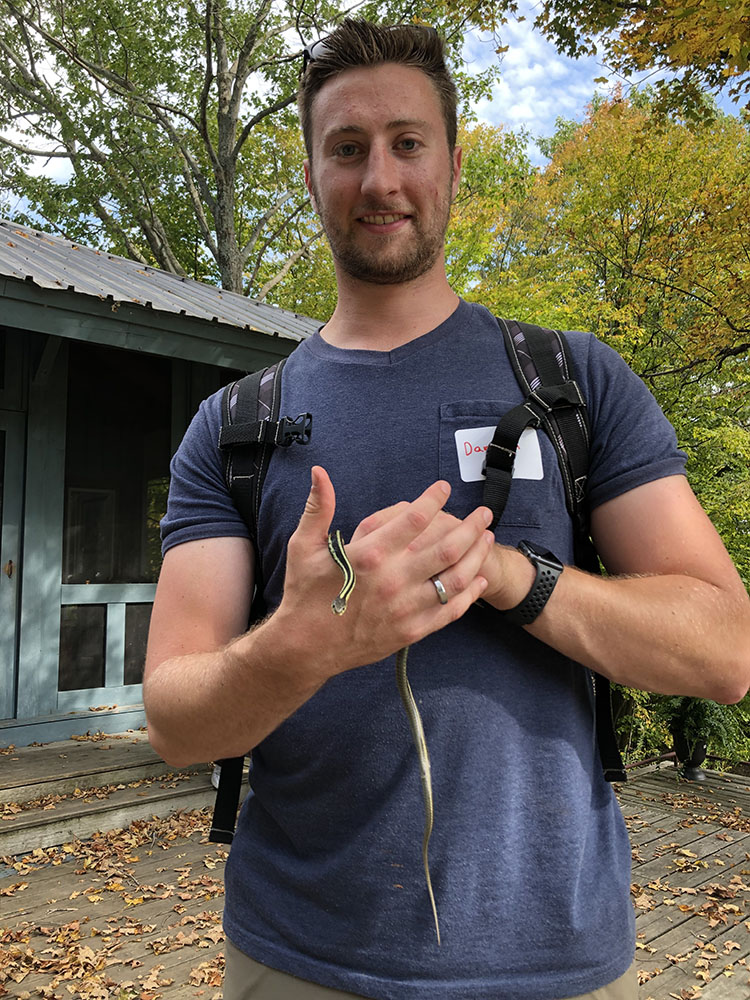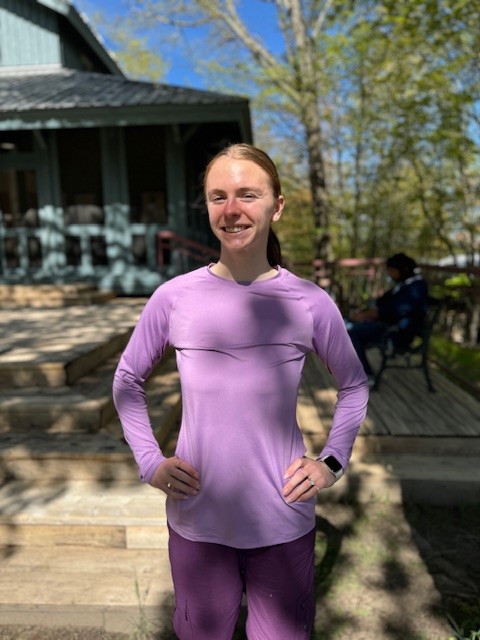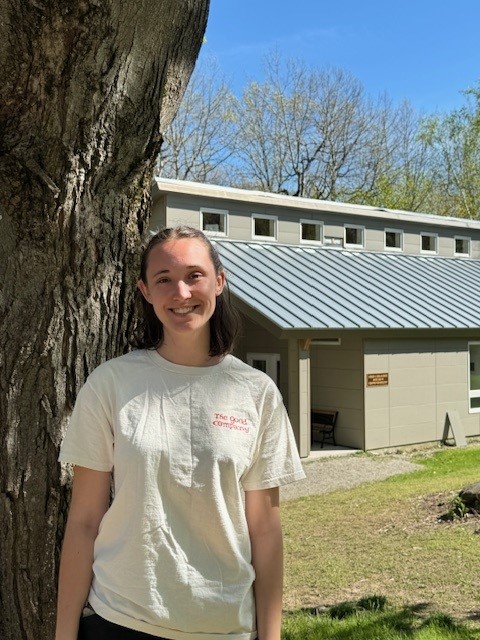People
PEOPLE
(research)
(resources)

(DAY-mee-an) he/him
Infectious diseases are a growing threat to global health and prosperity. Ticks and tick-borne pathogens are known to be some of the most prevalent zoonotic diseases globally. With climate change increasing tick range limits, there are new opportunities for hybridization and speciation. In order for public health officials to develop effective mitigation strategies, it is important that we understand which species are present and how they are interacting with different hosts and pathogens. My research focuses on understanding the molecular and population genetics of ticks within Eastern Ontario. Through the use of Genotyping-in-Thousands by sequencing (GT-Seq) and high-throughput sequencing, I hope to better understand tick species diversity and population dynamics.

(mah-REE-ah HOE-zeh) she/her
Understanding plant local adaptation in response to climate change is crucial for conservation and restoration of plant communities. This is especially for Arctic and boreal forest populations species that are at or near their northern range limit. My research uses population and quantitative genetic techniques to understand population structure and evolutionary forces to understand the response to climate variation of plant communities in Canada's Northwest Territories. I am interested in understanding the evolutionary processes that can lead to population differentiation and local adaptation by combining molecular biology with quantitative techniques.
For my research I combine field experiments with high-throughput sequencing techniques, such as genotyping-by-sequencing, to help manage and conserve native plant communities. My PhD project is in collaboration with the Aurora College in the Northwest Territories, which allows me to connect research with community-based interactions that complement my personal interests in science communication and community-engaged scholarship and education.

(MAY-bell or ma-BELL) she/her
All organisms adapt to changes in their surrounding environments. Plants may synchronize the timing of critical life stages to maximize survival and reproduction in environmental conditions that are constantly changing. For example, plants may alter flowering time to maximize pollinator visits while minimizing herbivory. Plants can respond to environmental challenges through adaptive evolution and phenotypic plasticity. Genetic changes arise as a result of natural selection while phenotypic plasticity is mainly regulated through variable gene expression. Rapid evolution and inducible trait variation may both be important mechanisms of plant invasion. My thesis applies transcriptome sequencing to study plasticity and genetic variation in gene expression of two invasive plants: Lythrum salicaria (purple loosestrife) and Alliaria petiolata (garlic mustard).

(JU-lee-ah) she/her
I am broadly interested in whether climate warming will exacerbate plant invasion and affect local plant diversity through potential changes in the structure of soil microbial communities. Specifically, I am conducting a field experiment at Queen’s University Biological Station (QUBS), to look at the effect of artificially elevated temperature on the growth and invasion intensity of Alliaria petiolata (garlic mustard) and Vincetoxicum rossicum (dog-strangling vine) over time, as well as their potential influences on the composition and colonization of mycorrhizal families in soil and native plant diversity. My research aims to improve the threat assessment of invasive plant species under escalating climate warming, providing insights into the ecological impacts of invasive species (including their mutual interactions) on native ecosystems in temperate regions through field manipulations and soil analysis.

(sree-VAT-shun) he/him
Tick-borne diseases have seen a rapid increase in the incidence across Canada. Ticks act as vectors for a variety of pathogens which include Borrelia burgdorferi (Lyme disease), Anaplasma phagocytophilum (anaplasmosis), and Borrelia miyatomi (relapsing fever). Symptoms of tick-borne diseases are variable and non-specific but include neurological disorders, depression, mood, behavioral changes, and musculoskeletal problems. These symptoms change over time and are sometimes complicated, increasing the difficulty in diagnosis. Research shows that the gut microbiome plays a vital role in neurological diseases, pain, and behavioral changes. However, the gut microbiome effects are not widely explored in the context of tick-borne diseases. So, for my research, I will be exploring the interactions between tick-borne pathogens and the gut microbiome that affect pain and behavior in rodents.
For my PhD thesis, I will be incorporate high-throughput sequencing techniques along with laboratory mouse studies and pain assays. The experiments will be conducted in both controlled laboratory and field environments. This research will be in collaboration with the University of Ottawa and the University of Saskatchewan. Additionally, I will be developing strategies for target enrichment and host depletion in the tick microbiome.

(LOW-gan) she/her
In recent decades, we have observed rapid Ixodid tick geographic range expansion primarily due to climate change. Tick range expansion is accompanied by the collection of microbes known as the microbiome, which includes various harmful pathogens that greatly impact human health and well-being. As these ranges expand, it is crucial to understand how the microbiome diversity may be altered during feeding. This can be used to determine if and when ticks are more likely to acquire and spread pathogens that cause human illnesses including Lyme disease, Rocky Mountain spotted fever, and Relapsing fever. Furthermore, research on ticks and how environmental factors, such as geographical location, temperature, humidity, season, habitat type, and soil type, impact the microbiome composition is needed. Using state of the art field and lab techniques, I am studying the impact of tick feeding and engorgement on microbial diversity. This research is a crucial step towards the development of effective mitigation strategies for the spread of tick-borne pathogens.

(EM--ah-lee) she/her
The Anthropocene is threatening global diversity, notably through the introduction of invasive species. Understanding these threats is integral to agriculture and biodiversity conservation in Canada. The focus of my research is to investigate the effect of climate warming and plant invasions on the soil microbial community in southeastern Canada. My research focuses on two invasive species: Alliaria petiolata (garlic mustard) and Vincetoxicum rossicum (Dog strangling vine or DSV). These two species live very different differ in below-ground interactions. Specifically, Vincetoxicum rossicum benefits from symbiotic mycorrhizal fungi whereas Alliaria petiolata does not benefit, or may even actively disrupt Mycorrhizal associations with other plants. I hope my research can contribute to understanding the taxonomic and functional diversity of the soil microbial community under invasion

(JESS-ih-kuh ) she/her
Invasive species can be used as a model for studying evolution and adaptions at an accelerated pace. My research will use the invasive plant Lythrum salicaria to determine if there is an underlying genetic component to plant herbivore defense. Specifically, I will be focusing on the difference between herbivore tolerance vs inducible resistance.
(RAH-bert) he/him
 The Anthropocene is marked by several threats to global biodiversity, including climate change, large-scale habitat modification, and long-distance translocation of species across major dispersal barriers (e.g. oceans, mountain ranges, deserts). As a result, species are experiencing environments that are novel with respect to the range of conditions experienced throughout their recent evolutionary history. Rapid evolution in novel environments could prevent extinction, alter species interactions, and ultimately shape the structure and function of ecosystems, yet contemporary evolution and its effects on ecological dynamics are rarely studied in natural populations with a history of human perturbation. Researchers in our group are working hard to understand how and why contemporary evolution occurs in novel environments, and how this influences ecological dynamics.
The Anthropocene is marked by several threats to global biodiversity, including climate change, large-scale habitat modification, and long-distance translocation of species across major dispersal barriers (e.g. oceans, mountain ranges, deserts). As a result, species are experiencing environments that are novel with respect to the range of conditions experienced throughout their recent evolutionary history. Rapid evolution in novel environments could prevent extinction, alter species interactions, and ultimately shape the structure and function of ecosystems, yet contemporary evolution and its effects on ecological dynamics are rarely studied in natural populations with a history of human perturbation. Researchers in our group are working hard to understand how and why contemporary evolution occurs in novel environments, and how this influences ecological dynamics.
To help address these questions, we apply cutting-edge advances in next-generation sequencing with tried-and-true methods in basic ecology and quantitative genetics. We combine meticulous field studies at Queen's University Biological Station (QUBS) with global-scale collaborative projects to produce scientific discoveries that are both locally accurate and globally relevant. Understanding the genetic and environmental basis of ecological success in novel environments will be important, not only for reducing the impacts of invasive species, but to improve management of local crop varieties and other vulnerable species that are struggling to persist in the face of rapid global change.
See also: collaborators at myLyme.ca and the The Canadian Lyme Disease Reseearch Network, now TickNet
| Jake Alexander (ETH Zurich) |
| Jill Anderson (University of Georgia) |
| Pedro Antunes (Algoma University) |
| Dan Atwater (Earlham College) |
| Spencer Barrett (University of Toronto) |
| Oliver Bossdorf (University of Tuebingen) |
| Katrina Dlugosch (University of Arizona) |
| Chris Eckert (Queen's University at Kingston) |
| Jill Hamilton (North Dakota State University) |
| Anna Hargreaves (McGill University) |
| Ruth Hufbauer (Colorado State University) |
| Manisha Kulkarni (University of Ottawa) |
| John Maron (University of Montana) |
| Tom Mitchell-Olds (Duke University) |
| Hugh MacIsaac (University of Windsor) |
| Riyadh Muhaidat (University of Yarmouk) |
| David Reed (Queen's University / Kingston Health Sciences Centre |
| Loren Rieseberg (University of British Columbia) |
| Prameet Sheth (Queen's University / Kingston Health Sciences Centre |
| Calvin Sjaarda (Queen's University / Kingston Health Sciences Centre |
| Name | Degree | Project | Year | Post-lab experience |
|---|---|---|---|---|
| Sima Afsharnezhad | Postdoc | Tick pathogen detection | 2022-24 | Entrepeneur/Startup Company |
| Graeme McLeod | Lab Manager | various | 2019-20 | Public Health Ontario Laboratory |
| Amber Paulson | Postdoc | Tick microbiome | 2021 | BC Environment & Climate Change |
| Almira Siew | Lab Manager | various | 2018-19 | Octane Medical Group |
| Name | Degree | Project | Year | Post-lab experience |
|---|---|---|---|---|
| Muzzammil Abdur-Razak | MSc | Lythrum herbivory | 2016 | Employed |
| Mia Akbar | MSc | Lythrum herbivory | 2024 | PhD in Johnson Lab at U Toronto Mississaugua |
| Shrey Anand | MSc | Lyme disease | 2024 | Data Analyst |
| Katherine Duchesneau | MSc | GM Soil microbiome | 2019 | PhD in Kostka Lab at Georgia Tech |
| Richard Honor | MSc | GM eco-evo | 2019 | Environmental Researcher |
| Andrew Le | MSc | DSV Allelopathy | 2024 | Production Lab Technician, Corteva Agriculture |
| Eugene Sit | MSc | Lythrum evolution | 2021 | Authorization Specialist, BC Public Service |
| Sherise Vialva | MSc | Alliaria + Vincetoxicum | 2024 | Conservation |
| Yihan Wu | MSc | Lythrum + Alliaria genomics | 2019 | PhD in Adams Lab, University of British Columbia |
| Name | Degree | Project | Years | Post-lab experience |
|---|---|---|---|---|
| Nikolay Alabi | BSc (mentorship) | Alliaria genome | 2018-19 | MD/PhD Candidate, UBC |
| Rhett Andruko | BSc (USRA) | GM + maple @ QUBS | 2017 (summer) | 2018 MSc, School of Forestry, Alberta |
| Meagan Antunes | BSc Honours | Tick microbiome | 2018-19 | Bioinformatics MSc, U Bern, Switzerland |
| Emily Bao | BSc (work study) | baRcodes | 2016-18 | Scotiabank, Operating Systems Team Member |
| Stephanie Barre | SLC (Co-op) | Lab Technician | 2015-16 | Medical Lab Tech, LifeLabs |
| Weihang (Kathleen) Chen | BSc (Co-mentorship) | Ticks + GM | 2016-17 | Junior Bioninformatician, Harvard Medical School |
| Scarlet Choi | BSc (mentorship) | Technician | 2018-19 | Intern: PnuVax SL Biopharmaceuticals INc. |
| Adrian Diaz | BSc (Mitacs Intern) | Tick microbiome | 2019 | |
| Kate Ding | BSc (mentorship) | Tick microbiome | 2018-19 | Vet Clinic Employee |
| Maya Dixon | BSc (thesis) | Garlic Mustard genetics | 2018-19 | PhD, Columbia University |
| Jacqueline Edwards | BSc (thesis) | Invasion 'Hotspot' | 2023-24 | |
| Kai Ellis | BSc (thesis) | Tick microbiome | 2019-2020 | |
| Ke Fang | BSc (Mitacs intern) | Mitacs mentorship | 2018 (summer) | MSc in Molecular Biology |
| Leila Forsythe | BSc (thesis) | Lythrum herbarium | 2015-16 | 2016 began PhD with Ben Gilbert, U Toronto St.George Campus |
| Erika Gibbons | SLC (Co-op) | Lab Technician | 2015-16 | |
| Anneke Golemeic | BSc (thesis) | GM root colonization | 2017-2018 | 2018 MSc with Risa Sargent, U Ottawa |
| Victoria Guba | BSc (mentorship) | Tick ID | 2016 | 2018 Concordia, MSc in Environmental Assessment |
| Arnav Gupta | BSc (Mitacs intern) | Tick microbiome | 2019 | MSc in Computational Biology, Carnegie Mellon University |
| Pallavi Gupta | BSc (mentorship + thesis) | Tick microbiome + Betula genetics | 2017-19 | Medical Student, Czechia |
| Nicolai Hermann | Mitacs | Lythrum imaging | 2022 | MSc(2025), PhD in progress |
| David Huang | BSc (mentorship) | Tick microbiome + Betula genetics | 2020-21 | MD/MEng U Toronto |
| Sierra Klueppel | BSc (thesis) | Lythrum flowering time + herbivory | 2017-2018 | Nautilus Environmental, Laboratory Biologist |
| Jordana de Lima | BSc (Co-mentorship) | Tick genome | 2016-17 | 2018 Brasil to complete degree (Science without Borders) |
| Adam Levitan | BSc (thesis) | Tick genome | 2021-22 | 2018 Brasil to complete degree (Science without Borders) |
| Eliza Livingston | BSc (thesis) | Fish telometry | 2020-21 | Dentistry Student, Western U |
| James MacKay | BSc (thesis) | Maternal effects in Lythrum salicaria | 2018-19 | Ecologist, Redd Fish Restoration |
| Samara Manzin | BSc (thesis) | Lythrum genetics | 2020-21 | Ecologist, Redd Fish Restoration |
| Abby Mathews | BSc (thesis) | Tick pathogen testing | 2023-24 | MHSc, U Toronto |
| Mia Marcellus | BSc (thesis) | Garlic Mustard | 2019-2020 | MSc at McGill |
| Derek McLean | BSc (thesis) | Arctic birch DNA | 2016-17 | |
| Dale Moskoff | BSc (thesis) | Lythrum phenology | 2016-17 | PhD Student, U Toronto |
| Ahzum Mujaddid | BSc (mentorship) | Soil DNA extraction | 2018-19 | MSc at McGill |
| Evelyn Newman | BSc (thesis) | Purple loosestrife | 2019-2020 | MSc at Simon Fraser |
| Jessie Obeng | BSc (work study) | Lab servers | 2017-18 | 2018 eSight, Data Analyst |
| Indumathi Prakash | Mitacs | Tick testing | 2020-21 | MSc, U Chicago |
| Haley Richardson | BSc (thesis) | Amaranthus | 2018-19 | |
| Vanessa Sabourin | SLC (Co-op) | Lab Technician | 2016-17 | |
| Diego Sancho Kruppa | BSc (thesis) | Lythrum phenology | 2021-2022 | MSc, UBC |
| Megan Silverthorn | BSc (mentorship) | Lythrum trichome and stomata density | 2018-19 | Arnott Lab |
| Claire Smith | BSc (thesis) | Purple loosestrife | 2019-2020 | Junior Field Ecologist, eDNAtec |
| Joanna Strozak | BSc (mentorship) | Amaranthus | 2018-19 | |
| Angela Wong | BSc (thesis) | eDNA experiment | 2016-17 | Marketing, CCO |